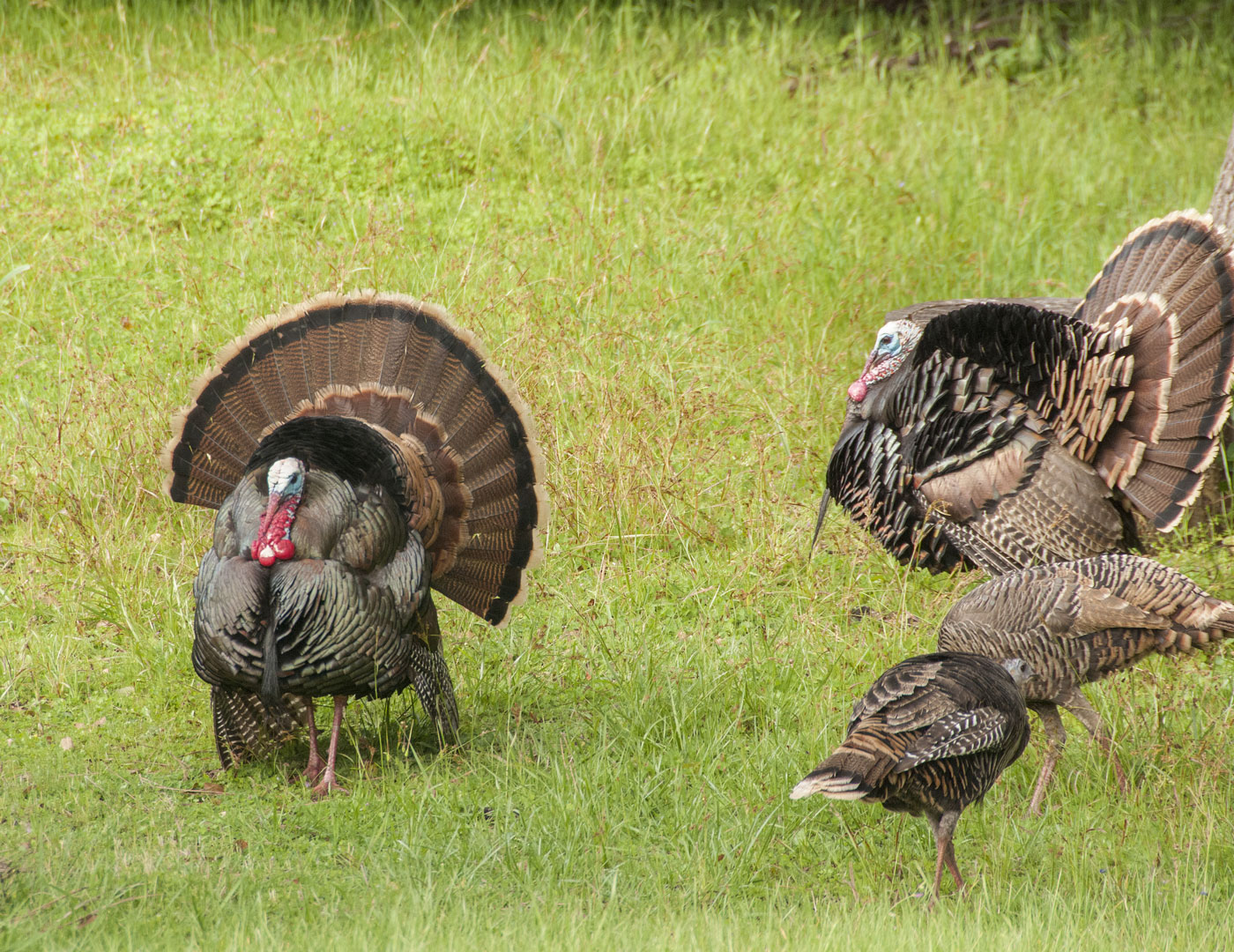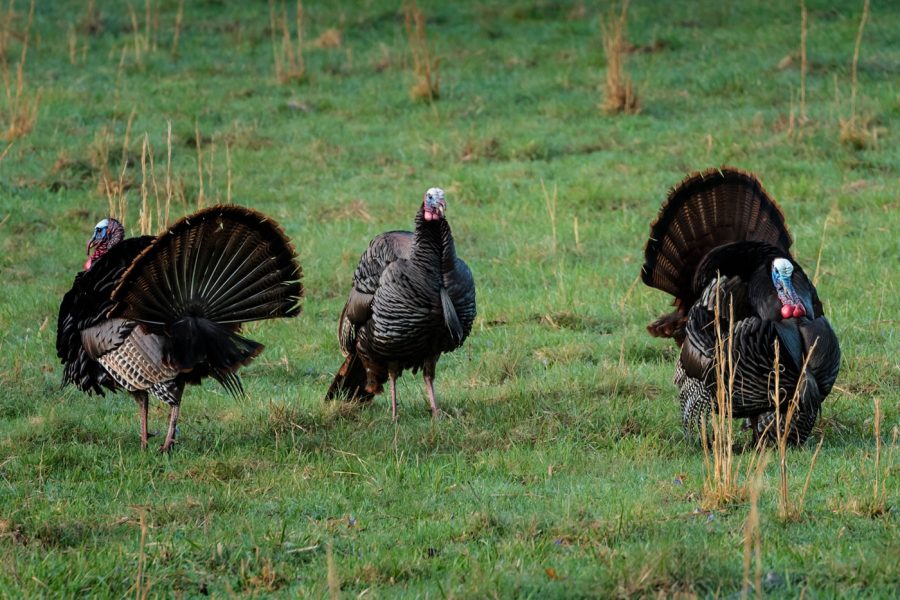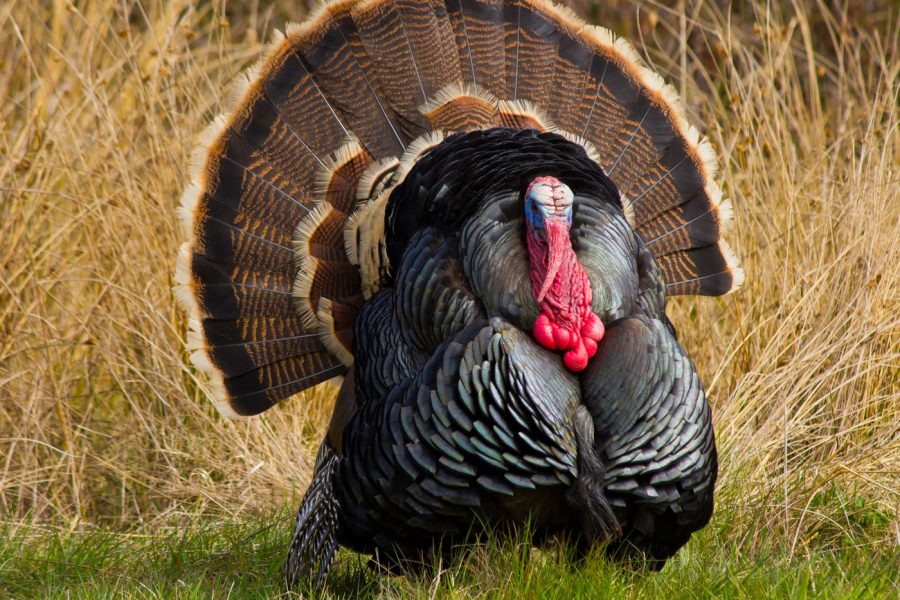Wild turkey hunting is one of the most adrenaline-pumping sports in the world. Each subspecies offers an enjoyable and tough hunting opportunity, making each hunt worthwhile.
As you face each new hunt, you have several challenges to overcome, from nailing down your locator calls to positioning decoys and everything in-between.
There are a variety of tried-and-true methods and techniques for bringing in a tom, but these short and easy-to-remember pointers can help you win your turkey hunting season no matter where you hunt.
Here is what the experienced turkey hunters at West Canyon Ranch suggest trying on for size the next time you set up a hunt.
HOW HARD IS TURKEY HUNTING?
Turkey hunting is a challenge for any hunter, whether hunting for the first time or the fiftieth. One of the main reasons why the sport is hard is because of the bird’s eyesight. The species boast an impressive eyesight range when compared to most other animals.
Luckily, with the right call, gear, set-up, and experience, you will develop techniques that bring toms to your front door.
When beginning to turkey hunt, our best words of advice are to remember that if a turkey approaches, don’t move. Their improved eyesight will spot you in a millisecond. Be aware of your surroundings so you can spot when they approach and be prepared for when it arrives.
After a while, you will understand the best turkey hunting techniques, and with a little bit of luck, you will bag a tom or two.
What Do You Use for Turkey Hunting?
According to the National Wild Turkey Federation, all you need to hunt wild turkey is a basic gear set-up.
A few of the most common options are a shotgun, muzzleloader, or bow. Both 12 and 20 gauge do a fantastic job of putting down a turkey, thanks to contemporary poultry loads and turkey chokes.
Even 410 shotguns using Federal Premium Ammunition’s TSS turkey loads make for great turkey hunting guns.
If you choose a bow, whether you prefer traditional, compound, or crossbow, be sure it’s one you can shoot comfortably from a seated posture.
As you hunt from a grounded blind, there are some logistical considerations to consider concerning your bow. For example, you have very limited space to draw back your bow.
Before going on your turkey hunt, sit in the blind and practice drawing. Ask yourself, “Is there enough room to comfortably draw?” If there isn’t, reduce your draw weight. Drawing too much weight is not only inconvenient, but it may also result in injury, pose a safety risk, and make your hunt a lot less enjoyable.
We also suggest speaking with a West Canyon Ranch professional to discuss what you will need on your guided turkey hunt in Utah.
What Time of Day is Best for Turkey Hunting?
When wild turkey hunting, your best shot is to get to your spot early. One tried-and-true technique is to set your alarm so that you will get to the roost tree half an hour earlier than you need to get there. Just remember that turkey hunting isn’t for the late riser. You might even need to wake up around 3:00 AM for a turkey hunt but losing sleep will be worth it once you get that perfect shot opportunity.
Getting to your spot early will give you time to settle in and set up your position before the first gobble of nearby turkey or the first call of the hens. It will also allow your nerves to settle to ensure you have the perfect position to make that quick shot.
Are you still not convinced that an early wake-up call is worth it? Consider how much better off you will be if your planned position doesn’t work out if you have extra time under your belt. Then, you will have the time you need to switch to another spot before ruining your day altogether. Another benefit to early hunts is that you will beat other hunters, maybe scoring a shot or two before anyone gets to your hunting area. Whatever your plan, waking up early will always provide you more good than harm.
How Do You Get a Turkey to Come to You
Developing a good call is key to getting a wild turkey to approach you while turkey hunting. When you overcall a tom and watch it disappear, you won’t easily forget your experience. Unfortunately, this is a lesson that most hunters must experience first-hand before understanding it fully.
The sooner you can recognize which calls to make and when the more gobblers you will attract and the more success you will have.
While some birds appreciate an influx of gobbles, the best piece of advice we can offer is to study the toms you wish to attract. Then, you can mimic what it likes, and it will eventually approach you.
Other Tips to Consider When Turkey Hunting
Go the Extra Mile by Packing More Calls
Ask any seasoned hunter what the worst feeling in the world is, and more than half will say getting to the hunting spot and not having the right call with you. Even if you planned your region down to the last detail, you could miss out by not packing several different calls. Sometimes a wild turkey will perfect one call over another, and the next week it will change.
Take our advice and pack several different slates, diaphragms, and box calls. Sometimes a tom will prefer one call to another and it is hard to know which call that will be ahead of time.
Don’t Expect Perfection Using Locator Calls
Coyote howlers, owl hooters, peacocks, and other locator sounds don’t have to sound exactly like the natural thing to encourage birds to gobble in your roost. On the contrary, gobblers respond better sounds that appear more natural or authentic, not perfect.
Keep in mind, as you try to replicate a locator call, you want to make a startling response. Instead of preparing the perfect call, you can also make a loud, screeching noise. This sound could make all the difference to entice a nearby gobbler.
Keep Coyote Howlers Away from Roosted Turkeys
The roosted male turkey may respond if you approach too closely in the morning, but they will be wary of approaching if you use a coyote howler. These hen yelps make them hesitant as it appears that a coyote may be near, and they won’t want to be its next meal.
Instead, use an owl hooter when you are close to the roosted turkey by a maximum of 200 yards.
Stalk Where Turkeys Roost
When roasting a turkey in the evening, try to locate the specific tree where the gobbler is roosting. After pinpointing where the roost is, you can organize your next day’s morning set up to ensure a successful hunt.
As you determine the exact location of the roosting tree, keep the following in mind:
- Decide where to set up based on what will be quickest
- Choose the exact tree you want to lean against and set up beneath
- Determine the direction where turkeys will descend, the direction the bird will not fly, etc.
We recommend using a GPS or map to make a note of the exact location you want to set up to make your morning easy. But no matter how you do it, do everything you can to ensure that the roosted gobble doesn’t see you. If it does, scrap the spot and try another.
Get Close to Grounded Gobblers
In the morning and mid-day, most turkeys are already on the ground. During this time, you should prospect the birds by walking ridges. Once a grounded gobbler responds, go as close to its position as you can without being spotted.
Set up and try to call again once you get close enough to the gobbler (within 100 yards). This method is far superior to dialing from the original location. Now, if you’re heading in the turkey direction and it gobbles loudly in your direction, get ready to make your shot.
Don’t Be Too Easy for Turkey
Encourage the gobbler to come to you, but don’t be too easy! Our best words of advice for wild turkey hunting are when a turkey starts to gobble. Sometimes your best strategy is to shut up. Most veteran turkey hunters like to rile the birds up and then turn them off by backing down.
Our rule of thumb is to give them two gobbles before calling again. If you adopt this strategy, expect a flock of turkeys to make their way towards you. However, there is a risk that the bird will flee because you remained silent. But, if you sparked some interest, the bird will most likely fly your way.
Have Patience
If you plan on night hunting, be patient and wait at your roost area. Our team often has our most successful hunts as we sit at places where we know birds roost. Every fifteen minutes or so, we will sit and call. Some of the best turkey shots happen in the last 30 minutes before fly-up.
For instance, let’s assume you set up at a roost 30 minutes before fly-up. Then you make a series of yelps, and a gobbler responds, but it seems at a far-off distance. You make a succession of exciting calls and then immediately shut up. The gobble will almost certainly come to inspect the area.
We suggest having patience, sitting still, and watching them fly into the roost trees. If they come but aren’t in range, go back first thing in the morning to set up shop.
Merriam’s Prefer Roosting at Ridgelines
When hunting Merriam’s turkeys, keep in mind that they prefer to roost on a ridgeline or at the very least where there is a contour break. The birds like to go uphill from their roost tree and then coast into the branch horizontally.
Following the ridgeline allows them to save energy by reducing the amount of time they spend flying. If you understand a tom’s roosting strategy, you will use it to your benefit. Instead of listening for a gobble, you will look towards the trees when you hear the noise of their wings flapping as the birds rise.
Give Roosting Areas a Twice-Over
When the nightly hunt fails to yield a roosted gobbler for the following morning, you have a few alternatives.
Sit tight in an area where you previously heard gobblers. Then, listen for gobblers in the area during primetime. If you can move while it’s dark, go after the noise. If not, wait until they fall to the ground and then sneak upon them. Boom—there is your best shot opportunity!
Cover as Much Ground as You Can
Another alternative is to travel as far as possible in the hope of hearing a roosted bird. You can cover the ground on foot or by car.
Our recommendation is to get up early in the morning, get in your car, and travel to an area where you last saw or heard turkeys.
Every half-mile, come to a stop and make a call on your peacock or coyote howler. Eventually, you will find a prime spot to set up shop.
Get Close
Before calling to a gobbler, attempt to approach as close to him as possible. When you see a gobbler, attempt to get as close to the turkey as you can without it seeing you.
If you are attempting your first call, try to get within 100 yards or closer (if the terrain and vegetation allow).
Find Rhythm
The tone and sound of your call aren’t as significant as the beat of the call you make. While this tip often receives flak from the hunting community, we notice a significant difference in our hunting success rates when we improved the cadence of our calls.
If your rhythm and tempo are consistent, you will attract more turkey than if it is off. Listen to the birds and concentrate on the timing and rhythm of their gobble. Then, do your best to mimic the pattern. We expect you to have tremendous results.
Focus on Decoy Positioning
If you position decoys correctly, they can be a big help. Place your turkey decoys at a 45-degree angle from the hunter, on the other side of where you think the gobbler will enter.
On the other hand, if you position them on the other side of where you want the birds to land, you will have difficulty landing a shot. Instead, set your decoys out to your around 25 yards to the opposite side of where the gobbler responds.
The bird will most likely respond to your call if you set your decoys upright. As it approaches, the gobbler will notice the decoys and stroll right past you on its way to the decoys on your opposite side.
As the gobbler gets close to the firing range, remember to stay silent. Then, you can fire away as it focuses on your perfectly placed decoys.
EXPERIENCE A ONCE-IN-A-LIFETIME TURKEY HUNT AT WEST CANYON RANCH
West Canyon Ranch is the expert you need by your side when it comes to wild turkey hunts, guiding your way. Trust our guides to provide you with the best-in-class experience at West Canyon Ranch as you explore our 4,000-acre hunting ranch in the northern Wasatch Mountains.
West Canyon Ranch is the place to hunt in Utah, thanks to our massive turkey sizes and our high success rates. Part of the northern region, we provide fully guided turkey hunts in the spring (April to May) and fall (September to November) and (October to December).
Plus, we can tailor our guided turkey hunts to any style of hunt you prefer, whether you prefer to turkey hunt with a rifle, shotgun, or a bow. Whatever medium you choose, expect to hunt Merriam turkeys. Because our ranch is near the Rocky Mountains, the Merriam population’s core hub, we can maintain a robust population of these bearded toms.
Merriam turkeys have light-colored tips on their tail feathers and wing feathers with more white and less black. With short to moderate beard lengths, they have the weakest gobble of all the turkey subspecies. Our adult males weigh between 18 and 30 pounds, while our adult females weigh between 8 and 12 pounds.
Book a stay at the Ranch to hunt these beautiful creatures. Included in your stay are all your meals, three days of housing, blinds, guides, airport transport, and field care. The only thing you will need to worry about during your stay is shooting your trophy tom.
No matter which types of hunts you are interested in booking, rely on West Canyon Ranch to give you a once-in-a-lifetime experience. Together, we will help your group have the best turkey hunt of our lives.
Learn more about the guided elk hunts offered in northern Utah by calling (435) 770-3421 or contacting us today.




